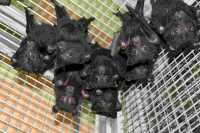
28 Feb Bats Carry Dangerous Viruses: Why Don’t They Get Sick?
MedicalResearch.com Interview with:
 Matae Ahn,MD-PhD candidate
Matae Ahn,MD-PhD candidate
Emerging Infectious Diseases (EID) Programme
Duke-NUS Medical School
MedicalResearch.com: What is the background for this study? What are the main findings?
Response: Bats, as the only flying mammals, are ‘special’ in their ability to host many highprofile viruses without suffering from disease. Such viruses including Ebola virus, Nipah virus and SARS or MERS coronaviruses, are highly pathogenic and often lethal to humans or animals, but yet cause no or minimal disease in bats. In addition, they also live very long relative to their small body size, despite elevated metabolic rates. However, what makes them special is still unclear.
In this study, we discovered dampened NLRP3-mediated inflammation in bats in response to both ‘sterile’ stressors and infection with three different types of zoonotic RNA viruses. We identified multiple molecular mechanisms of altered bat NLRP3, a critical regulator of virus-induced and age-related inflammation, as the cause. Importantly, the reduced inflammation had no effect on the viral loads, which suggests enhanced immune tolerance to infection in bats. Bats’ natural ability to dampen stress-related and virusinduced inflammation may be a key mechanism underlying their long lifespans and unique viral reservoir status.
MedicalResearch.com: What should readers take away from your report?
Response: We discover the dampened NLRP3-mediated inflammation as a key functional difference between bats and human/mouse. Multiple mechanisms underlying the altered NLRP3 were identified at both the mRNA and protein level. Significantly reduced inflammatory response to multiple zoonotic RNA viruses with no impact on viral loads provides evidence of enhanced immune tolerance rather than increased antiviral immunity. In other words, bats appear to be capable of limiting excessive or inappropriate virus-induced inflammation, which often leads to severe diseases in spillover hosts. Our findings may provide lessons for controlling human infectious diseases by shifting from the traditional specific “anti-pathogen” approach to a more broad “anti-disease” approach, as it seems to be successfully adopted in bats.
MedicalResearch.com: What recommendations do you have for future research as a result of this work?
Response: Unique biological features of bats, including a long lifespan with low frequency of cancer and a special reservoir host status, offer a great opportunity for us to identify new strategies or approaches for treating human viral and age-related diseases. As NLRP3-mediated inflammation is increasingly recognized for its central role in infection, aging and age-related diseases, our finding in this study may offer a broad avenue for further research. With our continuous establishment of more experimental reagents and tools for bat immunology, further in-depth characterization of immune responses in vitro and especially in vivo will elucidate more underlying mechanisms of resistance to viral diseases and aging. We are hopeful to conduct in vivo experiments in the next 1-2 years in bats and transgenic mice.
No disclosures
Citation:
Matae Ahn, Danielle E. Anderson, Qian Zhang, Chee Wah Tan, Beng Lee Lim, Katarina Luko, Ming Wen, Wan Ni Chia, Shailendra Mani, Loo Chien Wang, Justin Han Jia Ng, Radoslaw M. Sobota, Charles-Antoine Dutertre, Florent Ginhoux, Zheng-Li Shi, Aaron T. Irving, Lin-Fa Wang. Dampened NLRP3-mediated inflammation in bats and implications for a special viral reservoir host. Nature Microbiology, 2019; DOI: 10.1038/s41564-019-0371-3
[wysija_form id=”3″]
[last-modified]
The information on MedicalResearch.com is provided for educational purposes only, and is in no way intended to diagnose, cure, or treat any medical or other condition. Always seek the advice of your physician or other qualified health and ask your doctor any questions you may have regarding a medical condition. In addition to all other limitations and disclaimers in this agreement, service provider and its third party providers disclaim any liability or loss in connection with the content provided on this website.
Last Updated on February 28, 2019 by Marie Benz MD FAAD
